The weather is starting to cool down so it’s time for a quick pottage! I am always in the mood for a good stew, especially one that comes from a 265 year-old source.
I haven’t dabbled much in traditional Scottish food, but that is largely due to how few Scotland-specific recipe sources there are prior to the 18th-century Georgian era. As far as I can tell there are only a few surviving cookery manuscripts from the 17th century, the oldest being dated 1659. Wealthy Scottish women were known to keep recipes (medicinal and culinary) in personal manuscripts, which were passed down through the generations. If you want to browse the National Library of Scotland’s digitized collection, click here.
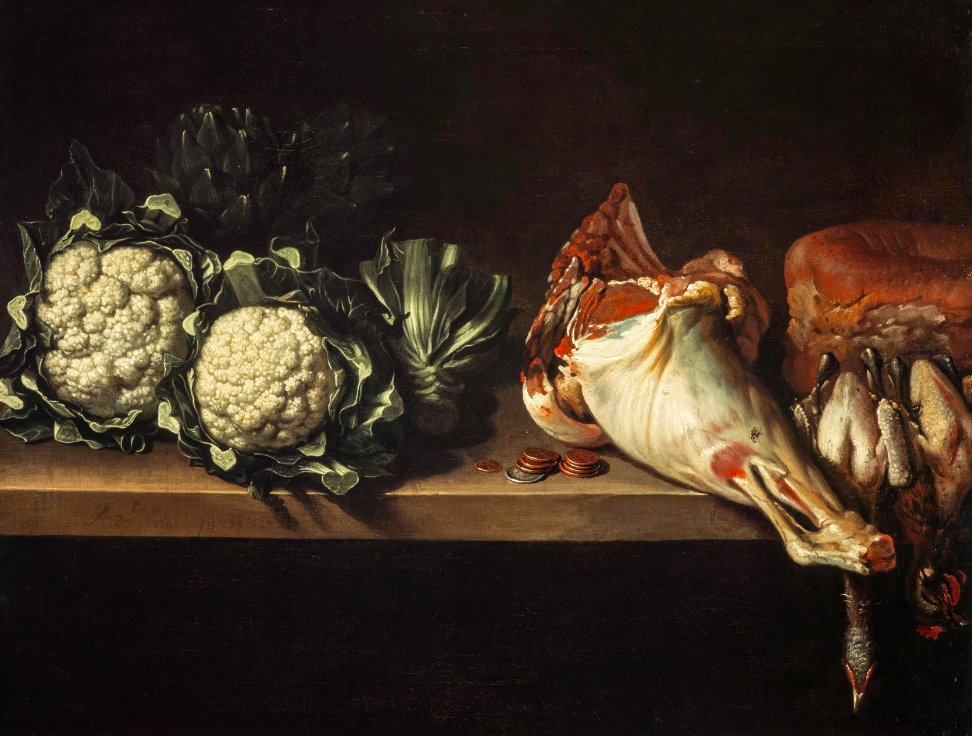
National Galleries Scotland
This recipe comes from one of the first cookbooks written and published in Scotland: A New and Easy Method of Cookery, written in 1755 by Elizabeth Cleland. A digitized copy can be accessed via HathiTrust.
Cleland was a cook and apparently ran a cooking school from her house in Edinburgh (in “the Luckenbooths” to be precise), which is also where she sold her cookbook. The book contains some 700 recipes with a large variety of Scottish and English dishes, from Flummery and “Dumplins” to Ox Cheeks and Scots Collops.
The Recipe
If you’re Scottish, and perhaps even if you’re not, you have probably heard of the traditional hearty soup called Scotch Broth. It is hardly a broth, as the name suggests, and a traditional recipe often contains beef or mutton, barley, split peas, onions, herbs and a variety of vegetables (carrots, turnips/”neeps“, potatoes, rutabagas etc.). Scotch broth even comes in a can!
Scotch broth- or its ancient culinary ancestor- originated centuries ago, and likely pre-dates any written history. Barley, beef and pottages have been food staples in Scotland since the time of the Picts!
Potatoes are a late addition to this dish since they didn’t arrive in Europe until the end of the 16th century. There is an impressively large selection of soup recipes in this cookbook and I find it interesting that potatoes are not in any of them.


To make Scots Barley Broth: Boil a hough of beef in eight pints of water, and a pound of barley, on a slow fire; let it boil to four pints; then put in onions, pepper, salt and raisins if you like them, or you may put in greens and leeks.
Ingredients:
- 4 pints (8 cups) beef stock or broth
- 1/2 lb. pearl barley or approx. 1 cup.
- 1 onion, chopped
- 1 leek, sliced
- 1/4 tsp. pepper or to taste
- 1/2 tsp. salt or to taste
- 1/2 cup raisins
- Handful of kale (optional)
Step ONE: The Broth
To make Scots Barley Broth: Boil a hough of beef in eight pints of water, and a pound of barley, on a slow fire; let it boil to four pints;
This step can be done one of two ways: make your own stock using a beef hough (cow shin) and water or use a prepared beef stock.
If you use a prepared stock, note that I’ve halved the recipe in the ingredient list above. Rinse your pearl barley and add to the broth. Cook over low heat until about half the liquid has been reduced and the barley is cooked, approximately 45 minutes to an hour. Stir occasionally to prevent the barley from sticking to the bottom of the pot.
The biggest dilemma I faced with this recipe is whether or not any of the meat would have been cut from the hough and left in the stew. Traditional scotch broths often have beef or mutton, but not all of them. It is common for early recipes to omit certain details that would have been obvious to chefs at the time, so it’s entirely possible that bits of instruction were left out or implied.
However, based on some of the other recipes in the book, I think the author would have specified chopping the meat into pieces if it was intended to be eaten that way. Coupled with the fact that shin meat is pretty tough unless it is slow-cooked for a very long time, I personally believe that the beef hough is in this recipe strictly to flavor the broth.
Step TWO: Season
…then put in onions, pepper, salt and raisins if you like them or you may put in greens and leeks.
Add your onions, leek, raisins and salt and pepper. Simmer for an additional 15 minutes or until everything is cooked through.
I found that sweating the onions beforehand (a light saute) helped ensure that they cooked through faster. The longer the soup cooks, the more broth is reduced or absorbed by the barley which leaves very little liquid at the end. Since the onions are added later, the soup will need to continue to simmer until they are not crunchy.
For a thinner stew, add more broth if needed. You shouldn’t need to add additional liquid if you cooked the barley over low heat.
Step THREE: Add Greens and Serve
If you want to add a bit more color and Scottish flair, add a handful or two of chopped kale. Stir it in until it wilts and serve.
The recipe simply says “greens” so there is some room for interpretation here. Historically, kale was an extremely common leafy green in Scotland, but other period greens could include spinach, beet leaves or parsley.
The Verdict:
This stew is so good and I can certainly see how something like this would be considered comfort food! I personally like the raisins in it, but you can leave them out if you’d like.
I made this a couple times and I do prefer the flavor when using beef broth over stock and definitely recommend adding the kale. Wholesome, filling and delicious.
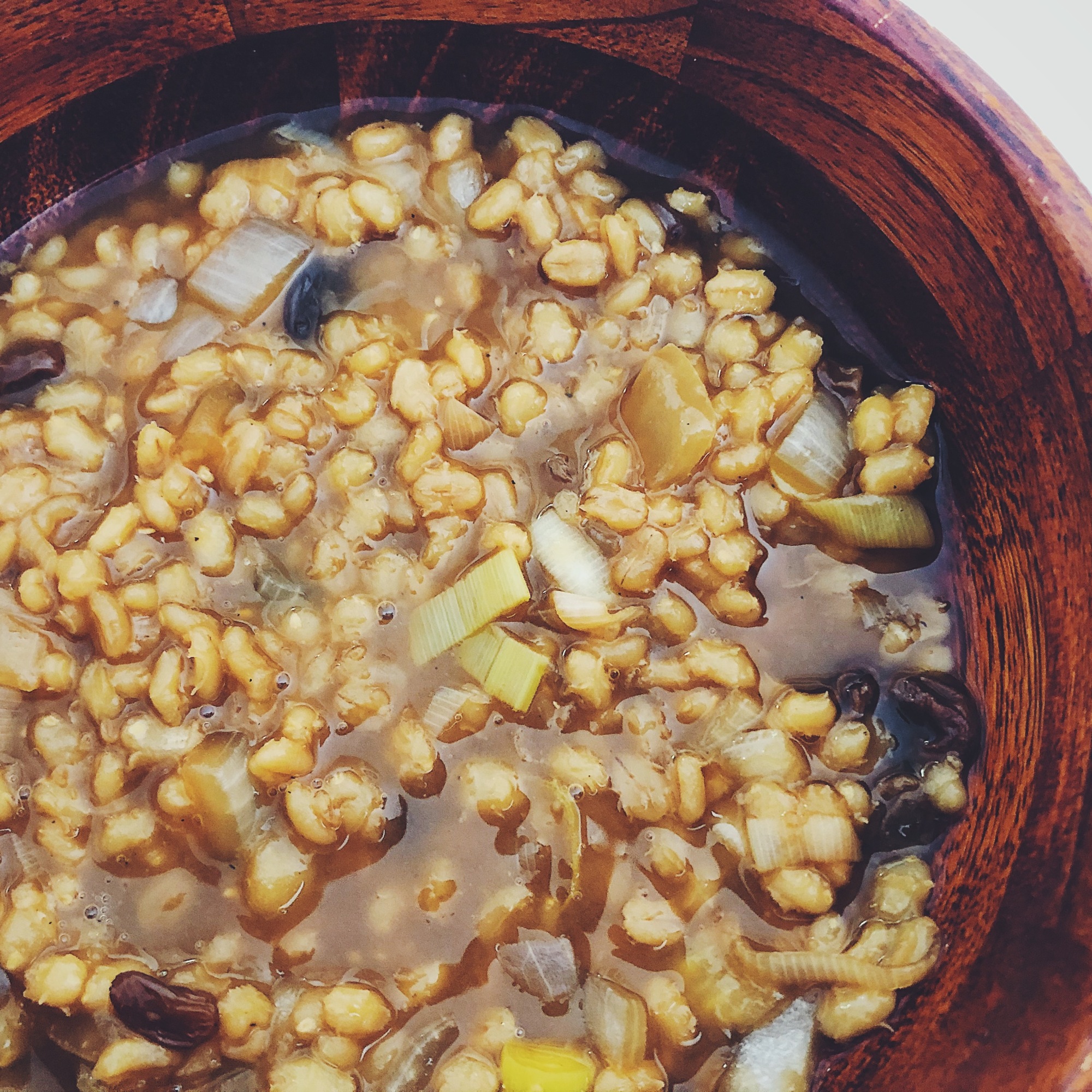
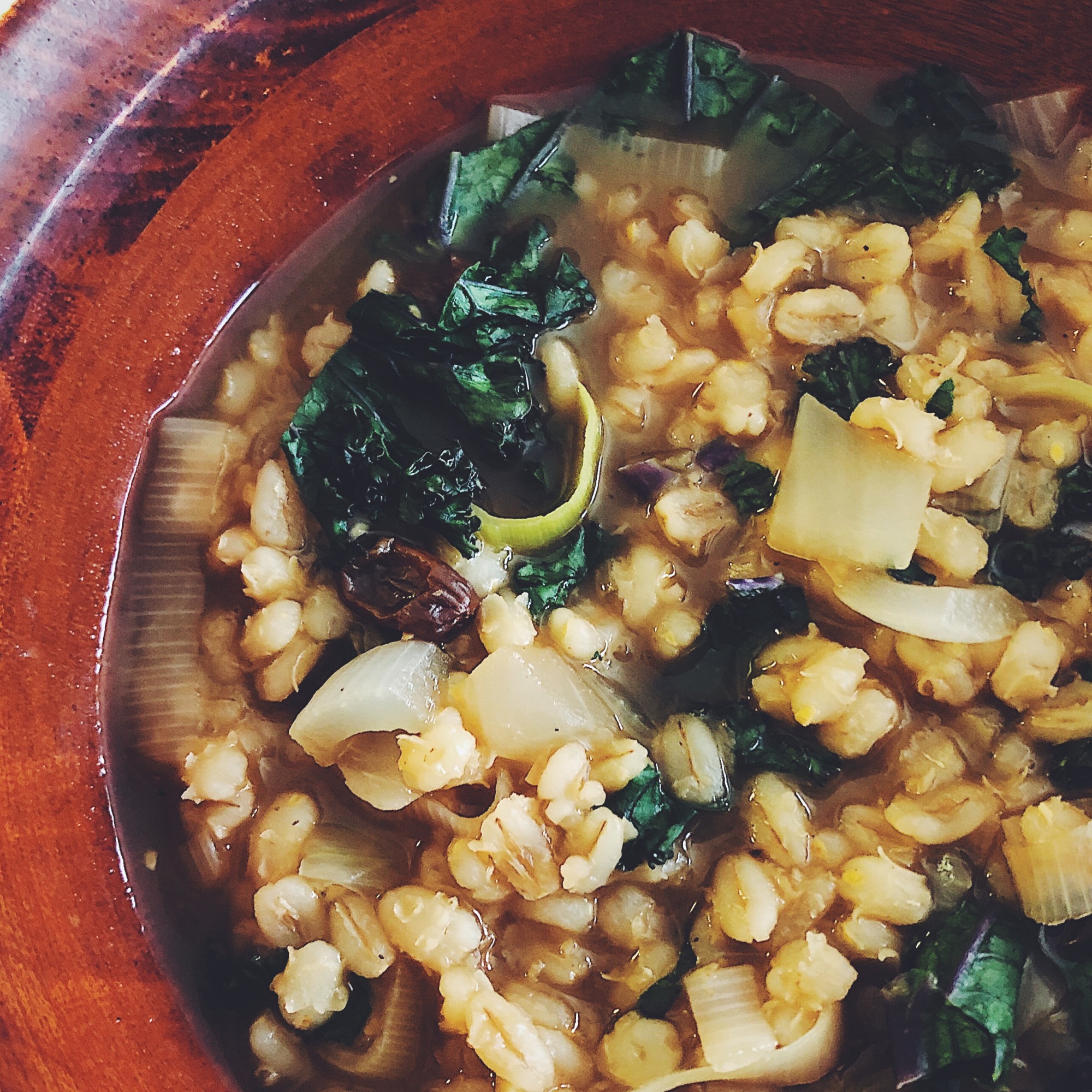
I have been trying to hunt down a beef shin but I’m wondering if they think I’m looking for beef “chin” because the staff at the meat counter seem confused when I ask through the face mask. Throwing the word hough around here just might confuse them further! Meat isn’t something I typically buy unless I have to, so luckily this version of Scotch Broth can be made with broth or stock without losing too much authenticity-wise.
The flavor of the broth will change somewhat depending on the broth/stock you use. For historical accuracy, use something a bit more plain or even homemade, without other ingredients in it. Better yet, if you can find a beef hough, replace the broth in the ingredient list with water and double the entire recipe.
If you’re interested, I found a couple other similar recipes in the cookbook that are a bit more like a modern Scotch Broth.
This one has mutton, barley, carrots, turnips, onions, herbs and even an optional sheep’s head. I am very intrigued and I’ll definitely give this one a try! Sans head, of course.
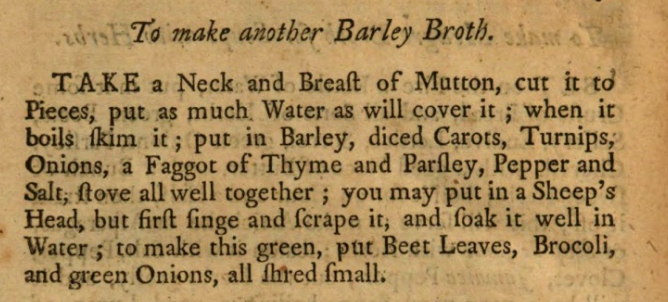
Mutton Broth uses boiled mutton, herbs, onions, turnips, barley/rice and parsley.
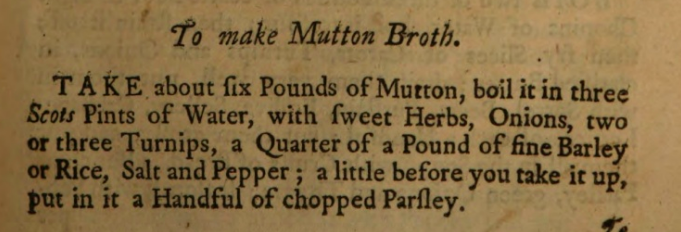
I hope you give this lovely barley soup a try and feel free to share your thoughts in the comments below!
Scotch Barley Broth
Ingredients
4 pints/8 cups beef broth or stock
1/2 lb. pearl barley
1 onion, chopped
1 leek, sliced thin
1/2 cup raisins
1/4 tsp pepper or to taste
1/2 tsp. salt or to taste
Chopped kale (optional)
Combine broth and barley and bring to a boil. Reduce heat to low and cook for 45 minutes to an hour or until half the liquid has been reduced and the barley is cooked. Sweat onions for 5 minutes. Add onion, raisins, leek and seasonings and simmer for an additional 15 minutes or until cooked through. Stir in kale until it wilts and serve.
If preferred, omit beef broth and cover a beef hough/shin with 8 pints (16 cups) of water. Double remaining ingredients.
I really enjoy the historical context of your posts … the food history is so fascinating! It’s hard to imagine that a food so presently common as potatoes was once unavailable in Europe. Love the idea of Elizabeth Cleland selling cookbooks and teaching lessons from her 1700s home. 😄
LikeLiked by 2 people
Thanks so much Rebekkah! It’s been really interesting and fun to explore history using food as the focus. There’s a lot that we take for granted, I think.
LikeLiked by 1 person
Great post! Scotch Broth is my favorite Scottish soup. Love this giant barley grains 🙂 Very comforting, perfect for cold, rainy days.
LikeLike
Thanks Paula! I really enjoyed this soup. 🙂
LikeLike
Waw the Portuguese Moorish chicken looks tasty
LikeLiked by 1 person
One of my favorites!
LikeLiked by 1 person
I am all in for the food history. I will remember this recipe for wintry days yet to come! Thanks for sharing!
LikeLike
I’m glad you like it!
LikeLike
Scotch broth ….mmmm…….sounds interesting … 😊😇😇
LikeLiked by 2 people
hmmm amazing wow am now hungry Lolz, it is wonderful this post. You can also check mine too https://www.makeoverarena.com/waptrick-games-videos-mp3-download-www-waptrick-com/
LikeLike
Fascinating! I love how recipes and food stories really do breathe life into history. Thank you!
LikeLiked by 1 person
Thank you for this piece!
LikeLiked by 1 person
Old recipe, Healthy recipe!
LikeLiked by 1 person
I really appreciate that you included the link to the recipe book and other recipes in the National Library of Scotland’s collection. I love to look at old things like that, and I never even thought to check out the National Library of Scotland. Glad you liked the dish, I’ll have to try it myself someday.
LikeLiked by 1 person
Accurate and thorough sourcing is important to me, so I’m glad you found the links useful!
LikeLike
interesting, I have some mutton neck chops in my freezer (albeit from Yorkshire not Scotland), must try this
LikeLiked by 1 person
It really feels good to find an idea blog post such as this, nice articles.
LikeLike
Happy to have discovered your blog!
LikeLiked by 1 person